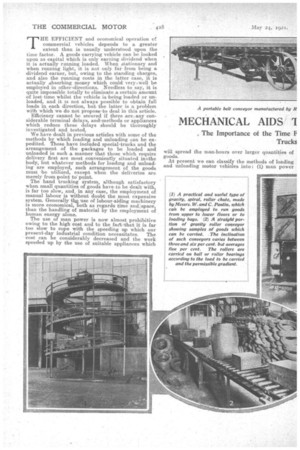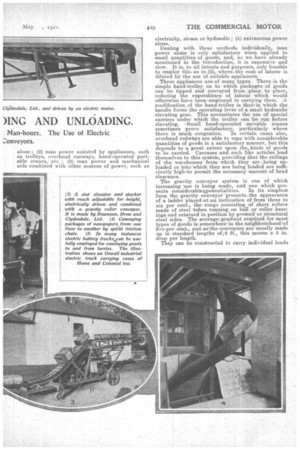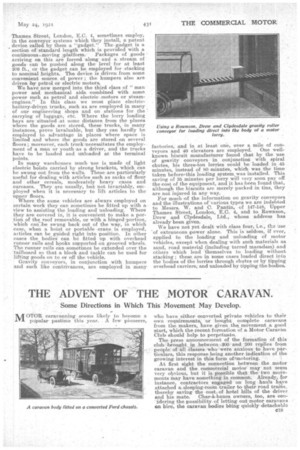MECHANICAL AIDS 1 )ING AND UNLOADING.
Page 12

Page 13

Page 14

Page 15

If you've noticed an error in this article please click here to report it so we can fix it.
THE EFFICIENT and economical operation of commercial vehicles depends to a greater extent than is usually understood upon the time factor. A goods carrying vehicle can be looked upon as capital which is only earning dividend when it is actually running loaded. When atationary and when running light, it is not only far from being a dividend earner, but, owing to the standing charges, and also the running costs in the latter case, it is actually absorbing money which could verytwell be employed in other,directions, Needless to say, it is quite impossible totally to eliminate a certain amount of lost time whilst the vehicle is being loaded or unloaded, and it is not always possible to obtain full loads in each direction, but the latter is a problem with which we do not propose.to deal in this article.
Efficiency cannot be secured if there are any considerable terminal delays, andunethods or appliances which reduce these delays should be thoroughly investigated and tested.
We have dealt in previous articles with some of the methods by which loading and unloading can be expedited. These have included special.trucks and the arrangement of the packages to be loaded and unloaded in such a manner that those which require delivery first are most conveniently situated inAhe body, but whatever methods for loading and unloading are employed, such arrangement of the goods must -be utilized, except when the deliveries are merely from point to point.
The hand trucking system, although satisfactory when small quantities of goods have-to be dealt with, is far too slow, and, in any case, the employment of manual labour is without doubt the most expensive system. Generally tba use of labour-aiding machinery is more economical, both as regards time and:,space, than the handling of material by the employment of human energy alone. The use of man power is now almost prohibitive owing to the high coat and to the fadt,that it is far too slow to cope with the speeding up which our
present-day industrial condition necessitates. The cost can be considerably decreased and the work speeded up by the use of suitable appliances which will spread the man-hours over larger quantities of goods.
At present we can classify the methods of loading and unloading motor vehicles into : (1) man power alone ; (2) man power assisted by appliances, such as trolleys, overhead runways, hand-operated portable cranes, etc. ; (3) man power and mechanical aids combined with other sources of power, such as electricity, steam or-hydraulic; (4) extraneous power alone.
Dealing with these methods individually, man power alone is only satisfactory when applied to small quantities .of goods, and, as we.have already mentioned M the introduction, it is expensive and slow. It is, to all intents and purposes, only feasible to employ this as in.(2), where,the cost of labour is diluted by the, use of suitable appliances.
These appliances are-of many types. There is the simple hand-trolley on to which packages of goods can be tipped and conveyed from .place to place, reducing the expenditure of labour which would otherwise have been ,employed in carrying them. A. modification, of the hand-trolley is that in which the handle forms the operating lever of a, small hydraulic elevating gear. This necessitates the use of special carriers under which the trolley can be run before elevating. -Small hand-operated movable cranes sometimes prove satisfactory, particularly where there is much -congestion. In certain eases also, overhead ruirways are able to cope with considerable quantities a goods in a satisfactory manner, but this depends to a great extent upon Hie, kinds of goods to be carried. Carcases and.such like articles lend themselves to this systein, providing that the ceilings of the warehouses from which they are ;being unloaded or into-which they are being loaded are sufficiently highzto permit the necessary amount of head clearance.
The gravity conveyor system is one of which increasing use is being made, and one which pre sents considerableqpotentialities. In its simplest form the gravity conveyor" presents the appearance of a ladder-placed.at;an inclination of'from three to six per cent, the rungs consisting of short rollers made of steel 'tubes running on hall or roller ,bearings and retained in position by pressed or structural steel sides. The averagegradient required for-most types of goods is somewhere in the neighbourhoo&of five-per cent., and.as'the.conveyors are usually made up in standard lengths of18 ft., this means a 5 in. drop per length. They can be constructed to carry individual loads of from a few ounces to over a ton, but it is more usual to make them strong enough to carry loads up to 3 cwts. The only stipulation as regards the types of goods to be carried is that each package must have one smooth, hard surface, as any projections would naturally wedge in between the rollers, and in the case of soft articles, such as sacks, the sagging between the rollers would prevent movement of the sacks by gravity, although, as a matter of fact, special runways provided with close-spaced rollers can, if necessary, be utilized for sacks, carcases, etc. This need not, however, prevent the use of ordinary type gravity conveyors for soft articles, as in such cases suitable containers can be employed.
Gravity conveyors can be made in combinations of straight and curved sections or spiral chutes, and provided with drawbridges, traps, junctions, switch sections, etc., exactly as in the case of railway lines.
Certain factories and warehouses lend themselves better than do others to the efficient use of these conveyors. Where goods are stored on the upper floors and have to be brought down to the ground level for loading, this can be achieved very simply ; in fact, by carefully arranging the conveyors, the goods can be brought down to the level of the lorry platform and only require packing into position. In such cases it is a good arrangement to store outward goods on a high level and to receive inward goods on a low level ; in the latter.case, it is only necessary when unloading, to connect up a conveyor with the lorry and the goods can be run right into the base
ment. A point which must be considered is that it is much easier to cheek quantities of goods as they are passing down a runway than when they are being handled by a number of men. An 8 ft. section of conveyor can often be usefully employed for running goods from a lorry to the ground and also for assisting in loading, the goods to be loaded being pushed up the rollers, which is considerably less difficult, especially when dealing with fairly heavy packages, than lifting them direct. In this connection a useful little appliance is marketed by Messrs. W. and a Pantin; this is a combination friction skid, roller skid, truck and ladder. Turned one way, it can be used as an ordinary skid' for barrels, etc. ; turned the other way, with its roller wheels uppermost, it can be used for loading; while if it is laid on the ground, wheels downwards, it can act as a hand truck and carry considerable loads.
Gravity conveyors alone are not always sufficient to meet all needs, and in such cases they must be combined with power, such as electricity or steam. This power is employed for operating elevating machinery, stackers, and what are known as bumpers, the use of the latter being for what is technically called "renewing the gradient," This is for elevating goods to a higher level in order to enable them to travel for long distances by the gravity conveyor without any further expenditure of power, manual or otherwise.
Ronson, Drew' and Clydesdals, Ltd., of 255, Upper Thames Street, London, E.C. 4, sometimes employ, in the conveyor systems which they install, a patent device called by them a "gadget." The gadget is a section of standard length which is provided with a
continuous-moving ...platform. Packages of goods arriving on this are forced along and a stream of goods can be pushed along the level for at least 200 ft., or the gadget can be employed for stacking to nominal heights. The device is driven from some convenient source of power ; the hump era also are driven by petrol or electric motors.
We have now merged into the third class of "man power and, mechanical aids -combined with some power such as petrol and electric motors or steamengines." In this class we must place electricbattery-driven trucks, such as are employed in many of our engineering shops and on stations for the carrying of luggage, etc. Where the lorry loading bays are situated at some distance from the places where the goods are stored, these trucks, in many instances, prove invaluable, but they can hardly be employed to advantage in places where space is limited and where the goods ate stored on several floors; moreover, each truck necessitates the employment of a man or youth as a driver, and the trucks have to be loaded and unloaded at the terminal points.
In many warehouses much use is made of light electric hoists carried by strong brackets, which can be swung out from the walls. These are particularly useful for dealing with articles such as sacks of flour and other cereals, moderately heavy eases and eszeases. They are usually, but not invariably, employed when it is necessary to lift articles to the upper floors.
Where the same vehicles are always employed on certain work they can sometimes be fitted up with a view to assisting the loading and unloading. Where they are covered in, it is convenient to make a portion of the roof removable, or with a hinged 'portion, which can.Abe swung back out of the way, in which ease, when a hoist or portable crane is employed, articles can be guided right into position. In other eases the bodie& can be fitted up with overhead runner rails and hooks supported on grooved wheels. The runner rails can sometimes be extended over the tailboard so that a block and tackle can be used for lifting goods on to or off the vehicle.
Gravity conveyors, in conjunction with humpers and such like contrivances, are employed in many factories, and in at least one, over a mile of conveyors and 40 elevators are employed. One wellknown biscuit manufacturer found that by the use of gravity conveyors in conjunction with spiral chutes, his three-ton lorries could be loaded in 45 minutes, instead of SO minutes, which was the time taken before•this loading system was installed. This saving of 35 minutes per lorry will very soon pay off the cost of the equipment, and it has been found that, although the biscuits are merely packed in tins, they are not injured in any way. For much of the information on gravity conveyors and the illustrations of various types we are indebted to Messrs. W. and C. Pantin, of 147-148, Upper Thames Street, London, E.C. 4, and to Rownson, Drew and Clydesdale, Ltd., whose address has already been given.
We have not yet dealt with class four, i.e., the use of extraneous power alone. This is seldom, if ever, applied to the loading and unloading of motor vehicles, except when dealing with such materials as sand, road material (including tarred macadam) and others which lend 'themselves to loading without stacking ; these are in some cases loaded direct into the bodies of the lorries through chutes or by tipping overhead carriers, and unloaded by tipping the bodies.
































